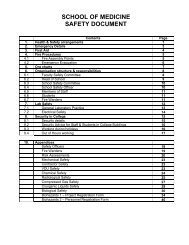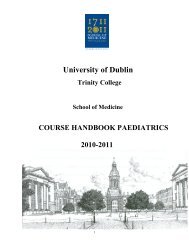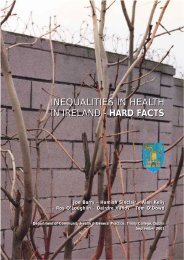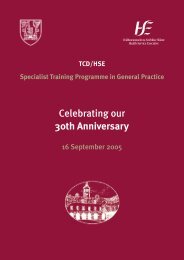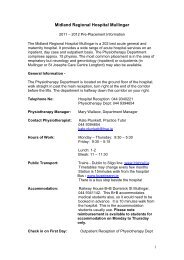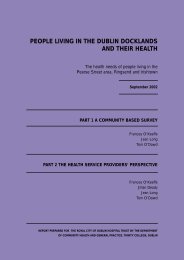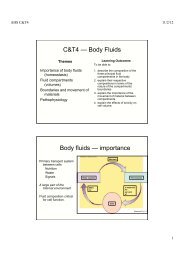people living in finglas and their health - School of Medicine - Trinity ...
people living in finglas and their health - School of Medicine - Trinity ...
people living in finglas and their health - School of Medicine - Trinity ...
You also want an ePaper? Increase the reach of your titles
YUMPU automatically turns print PDFs into web optimized ePapers that Google loves.
DISCUSSION - PART 2<br />
DISCUSSION<br />
PART 2<br />
Discussion<br />
This study was undertaken as part <strong>of</strong> the <strong>health</strong> needs assessment <strong>in</strong> the area. In general, the issues raised by<br />
the service providers support the f<strong>in</strong>d<strong>in</strong>gs <strong>of</strong> the household survey, which <strong>in</strong>dicates a consistent perception <strong>of</strong><br />
the <strong>health</strong> needs <strong>in</strong> the F<strong>in</strong>glas area.<br />
In the household survey, it was reported that over 16% <strong>of</strong> the surveyed population were aged 65 years or older<br />
which is higher than <strong>in</strong> the Eastern Region (10%). The service providers work<strong>in</strong>g <strong>in</strong> the study area reported that<br />
the ma<strong>in</strong> <strong>health</strong> needs were associated with an elderly population pr<strong>of</strong>ile. In the household survey, many primary<br />
carers identified enhanced services for the elderly as the most important resource required <strong>in</strong> the area, <strong>in</strong><br />
particular services to help older <strong>people</strong> to rema<strong>in</strong> <strong>in</strong> <strong>their</strong> own home. The service providers reiterated this f<strong>in</strong>d<strong>in</strong>g.<br />
The RAPID report conducted earlier <strong>in</strong> the year <strong>in</strong> West F<strong>in</strong>glas identified a high <strong>in</strong>cidence <strong>of</strong> both home<br />
burglaries <strong>and</strong> anti-social behaviour <strong>in</strong> the area. 3 Both service providers <strong>and</strong> primary carers highlighted the<br />
vulnerability <strong>of</strong> older persons <strong>liv<strong>in</strong>g</strong> <strong>in</strong> <strong>their</strong> own homes, <strong>in</strong> particular they raised the issue <strong>of</strong> <strong>their</strong> personal safety.<br />
Research has shown that older <strong>people</strong> can experience physical <strong>and</strong> psychological ill-<strong>health</strong> follow<strong>in</strong>g a crim<strong>in</strong>al<br />
episode perpetrated on them or on someone <strong>in</strong> <strong>their</strong> neighbourhood. 4 The service providers said that <strong>in</strong> <strong>their</strong><br />
experience, social isolation, lonel<strong>in</strong>ess <strong>and</strong> depression can be a consequence <strong>of</strong> crime <strong>in</strong> the neighbourhood.<br />
The service providers also spoke <strong>of</strong> the need for <strong>and</strong> gave suggestions on how to enhance the home-based<br />
services for the elderly. They stated that the reduced availability <strong>and</strong> flexibility <strong>of</strong> the Meals on Wheels service,<br />
for the unsupported elderly <strong>liv<strong>in</strong>g</strong> alone, has <strong>in</strong>creased <strong>their</strong> social isolation <strong>and</strong> decreased <strong>their</strong> weekly<br />
nutritional <strong>in</strong>take.<br />
The ma<strong>in</strong> <strong>health</strong> problems reported by the service providers were similar to those reported by the primary carers<br />
<strong>in</strong> the household survey. The most common chronic illnesses reported <strong>in</strong> both studies were cardiovascular<br />
disease, respiratory disease, arthritis, diabetes, depression <strong>and</strong> anxiety.<br />
Research has shown that deprivation is strongly l<strong>in</strong>ked with ill-<strong>health</strong>. 5 6 The service providers described the<br />
social problems that (<strong>in</strong> <strong>their</strong> experience) have a negative effect on <strong>health</strong> which <strong>in</strong>cluded substance misuse,<br />
poor hous<strong>in</strong>g, lonel<strong>in</strong>ess <strong>and</strong> isolation. The results <strong>of</strong> the household survey <strong>in</strong>dicates that this is a deprived area<br />
with 35% <strong>of</strong> households hav<strong>in</strong>g medical card cover, 25% <strong>liv<strong>in</strong>g</strong> <strong>in</strong> government supported or private rented<br />
accommodation <strong>and</strong> 40% hav<strong>in</strong>g primary education or less. The service providers reported that substance<br />
misuse (<strong>in</strong> particular alcohol) was a major issue <strong>in</strong> the area <strong>and</strong> had associated physical, mental <strong>and</strong> social<br />
implications. In contrast, drug <strong>and</strong> alcohol problems appear to be under reported <strong>in</strong> the household survey. The<br />
service providers stressed the lack <strong>of</strong> services <strong>in</strong> F<strong>in</strong>glas for those who misuse alcohol.<br />
The service providers were very positive about the value <strong>of</strong> different discipl<strong>in</strong>es work<strong>in</strong>g together as a team, a<br />
philosophy which is endorsed <strong>in</strong> the primary care strategy . 7 They displayed a will<strong>in</strong>gness to facilitate a team<br />
approach to primary <strong>health</strong> care <strong>in</strong> order to enhance the <strong>health</strong> care service for the <strong>people</strong> <strong>liv<strong>in</strong>g</strong> <strong>in</strong> the F<strong>in</strong>glas area.<br />
Accord<strong>in</strong>g to the service providers, team work at the primary care level could be enhanced through: additional<br />
human resources; team build<strong>in</strong>g exercises; formal <strong>and</strong> <strong>of</strong>ficially recognised team meet<strong>in</strong>gs between both private<br />
<strong>and</strong> public service providers; privacy for clients dur<strong>in</strong>g consultations, <strong>and</strong> communication technology. In <strong>their</strong><br />
op<strong>in</strong>ion this would lead to an effective primary care team.<br />
83






